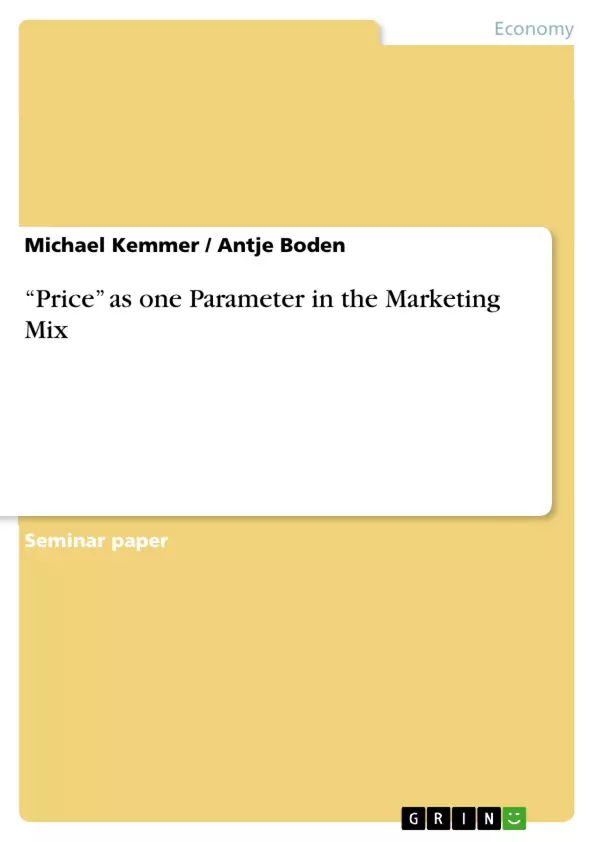When it comes to making buying decision, for example to buy a new car, the consumer is facing a numerous variety of prices for only one product. He or she has to decide whether to take the newest launched model or either the traditional one, with or without an insurance package, delivery or even buy from the internet. Naturally the consumer is reluctant to buy expensive products, when the run on
cheap ones are omnipresent in today’s market. Companies try to undercut one another and conduct themselves in would-be price battles. But all this is owed to the fact that on the one side the consumers have decreasing real earnings, which lead to a higher price sensibility, and on the other side the companies look at
saturated markets. These markets and their exhausted possibilities to differentiate the products cause a mass competition with the active implementation of pricing as a part of the marketing mix and as a competition instrument. This trend can not only be identified in the business to consumer (B2C) market, but it can also be found in
the business to business (B2B) market. In addition an increasing consolidation processes in large parts of the industry and retailing business is recognizable by applying purchasing agents to trade cheaper prices by using their power of demand. Classical examples are the two big discounters like ALDI and LIDL, when it is obvious that they pass over these good conditions to their consumers and use
this advantage in competition for their own business. Furthermore the internet with an increasing number of price comparison websites also contributes to this fight for the right price by offering price and product comparisons which hamper the strategies for a better price differentiation. A company’s survival and growth in such
challenging and competitive environment depends among other things on the effectiveness of its applied pricing policy.
Inhaltsverzeichnis (Table of Contents)
- Executive Summary
- 1. Introduction
- 2. Pricing Policy
- 2.1 Concept of Pricing Policy
- 2.2 Goals of Price Policy
- 2.3 What is a Price?
- 2.3.1 Definition of Price
- 2.3.2 Price and Consumer Value
- 2.3.3 The Drivers of Price
- 3. Methods of Setting Prices
- 3.1 Cost Orientated Pricing
- 3.2 Competitor Orientated Pricing
- 3.3 Customer Orientated Pricing
- 4. Price Strategies
- 4.1 New-Product Pricing Strategies
- 4.2 Price-Adjustment Strategies
- 4.3 Other Strategies
- 5. Ethical Constraints on Pricing
- 6. Results and Conclusion
Zielsetzung und Themenschwerpunkte (Objectives and Key Themes)
This assignment aims to explore the role of pricing within the marketing mix, analyzing its key aspects and its impact on business success. The work examines the methods and strategies used to establish effective pricing policies while also considering the ethical implications of price setting.- Understanding the concept of pricing policy and its role within the marketing mix.
- Exploring different methods of price setting, including cost-based, competitor-based, and customer-based approaches.
- Analyzing various price strategies, such as new-product pricing and price-adjustment strategies.
- Evaluating ethical considerations related to pricing practices and their impact on business decisions.
- Assessing the importance of pricing for achieving profitability and a sustainable competitive advantage.
Zusammenfassung der Kapitel (Chapter Summaries)
The assignment begins with an introduction that establishes the significance of pricing in today's dynamic market environment. It highlights the necessity for companies to adapt and implement effective pricing strategies to maintain competitiveness. The first chapter delves into the theoretical framework of pricing policy, defining price as a crucial element of the marketing mix alongside product, place, and promotion. It also discusses the fundamental goal of pricing policy, which involves balancing consumer satisfaction with company revenue generation while considering various influencing factors such as costs, competitors, and environmental conditions.
The second chapter examines various methods of price setting. It explores cost-oriented pricing, which focuses on the production costs associated with a product, and competitor-oriented pricing, which takes into account market conditions and competitor actions. The chapter concludes with customer-oriented pricing, emphasizing the importance of perceived value to the customer and its relation to price.
The third chapter delves into different price strategies, focusing on new-product pricing strategies such as skimming and penetration pricing. It also explores price-adjustment strategies, which involve tailoring prices to specific customer segments, and other strategies like discount pricing and segmented pricing.
The fourth chapter examines ethical considerations related to pricing practices. It explores the concept of ethical pricing and analyzes various factors that influence ethical decision-making regarding pricing. The chapter highlights the increasing importance of ethical pricing in today's competitive and customer-driven business environment.
Schlüsselwörter (Keywords)
This assignment focuses on the key concepts of pricing policy, marketing mix, price setting methods, price strategies, ethical constraints, and competitive advantage. The work emphasizes the importance of understanding and implementing effective pricing strategies in order to achieve profitability and long-term business success in a constantly evolving market.- Quote paper
- Michael Kemmer (Author), Antje Boden (Author), 2009, “Price” as one Parameter in the Marketing Mix, Munich, GRIN Verlag, https://www.grin.com/document/197106



